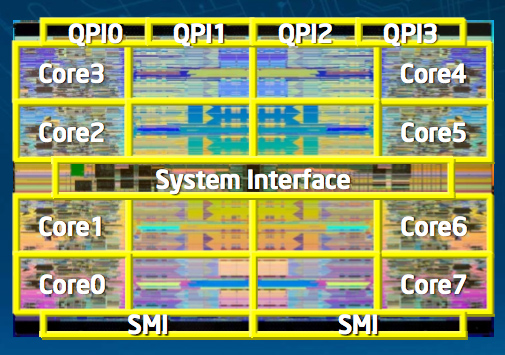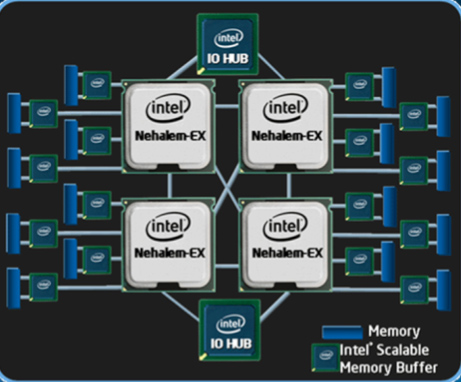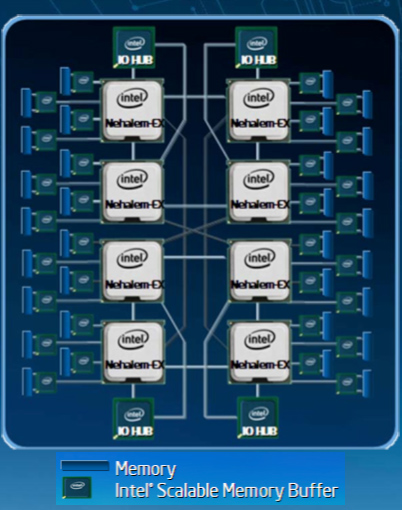Lab Update: SSDs, Nehalem Mac Pro, Nehalem EX, Bench and More
by Anand Lal Shimpi on May 27, 2009 12:00 AM EST- Posted in
- Anand
I had an epiphany the other day. Long time AnandTech readers will know that I used to do a far better job of keeping you guys apprised of what it was that I was working on. Somewhere along the way that got lost so today I’m going to try something...old, I guess. Here’s an update of what’s been going on.
The WePC Update
I've been working on a side project with ASUS called WePC.com. The idea is pretty cool: ASUS is tapping the community for ideas on what they'd like to see from its users in future notebook designs. I wrote about this at the end of last year but I've done a lot of work on it since then so I thought it'd be worthy of an update.
Last week I wrote about how simple it was to build a HTPC with a nice interface thanks to maturing integrated graphics platforms and good media center plugins. I also talked about the future arrival of Westmere and when the best time would be to buy your next laptop. Around the Athlon X2 7850 launch I talked about replacing aging PCs on a budget and seeing some pretty good performance results.
The netbook market is a very fast growing one so I broke out the crystal ball and tried to figure out where it was all going. I touched on NVIDIA v. Intel, the purported death of the desktop, SSD capacities and styling from a company other than Apple. It turns out I've written quite a bit over there, so check it out and join the discussion.
I’m working on SSDs Again
A couple major things have happened since my last in-depth look at SSDs. For starters, some drives now support the almighty Trim command. Both OCZ’s Vertex (and other Indilinx based drives) as well as the new Samsung drives should support Trim. Obviously you need the right firmware and you need an OS (or a utility) that supports Trim to take advantage of it, but it’s there and admittedly it’s there much earlier than expected.
That’s a good thing for drives like the new Samsung ones (Corsair’s new SSD is based on this drive) because their worst case scenario used performance is just bad. I’ve briefly touched on this in previous articles, but Samsung’s controllers don’t appear to do a good job of managing the used scenario I’ve been testing with. Thankfully, the latest controller’s support for Trim should help alleviate this issue. I’m still working on figuring out how to identify if a drive properly supports Trim or not.
I’ve also received the new OCZ Vertex EX (SLC) drives as well as the 30GB and 60GB variants of the MLC Vertex drives. The former is too expensive for most consumers but I’ll be putting it up against the X25-M to see how it fares in a high end desktop, all while trying to get enough together for Johan to do a proper enterprise level test. The 30/60GB Vertex drives are spec’d for lower write speeds so I’m going to be testing those (finally) to see what the real world impact is.
I can’t help but mention Windows 7 at this point, because I *really* want to switch to it for all of my SSD testing. Windows 7 is far more reliable from a performance standpoint. Although our recent article showed that it’s not really any faster than Vista, my SSD testing has shown that it’s at least more consistent with its performance results. Part of this I attribute to Windows 7 doing more intelligent grouping of its background tasks than Vista ever did, although it is surprising to me that we’re not seeing noticeably better battery life as a result.
How much would you guys hate me if I switched to Windows 7 sooner rather than later?
Nehalem Mac Pro: Upgrading CPUs
I actually finished testing the new Nehalem based Mac Pro several weeks ago, but in keeping up with tradition I had to see if it was possible to upgrade the CPUs on the new Mac Pro.
Indeed it is, but it’s a bit more complicated than you’d think.
Apple makes two models of the Mac Pro, one with two sockets and one with only a single LGA-1366 socket. The two socket model, often referred to as the 8-core Mac Pro, actually uses Nehalem CPUs without any heatspreaders. I suspect this is to enable them to run at their more aggressive turbo modes more frequently (high end Xeons can turbo up to higher frequencies than regular Xeons or the Core i7). The single socket model uses standard Xeons with heatspreaders, so there’s nothing special there.
I actually managed to kill a processor card doing the CPU swap but I’ve taken the hit so you all don’t have to :) It’ll all be included in the article, I’m simply waiting on a replacement heatsink since an integrated thermal sensor got damaged during the initial swap. For now just know that it is possible to upgrade the CPUs in these things and it’s not too difficult to, you just need to know what to expect and to be patient.
If you’re on the fence of buying today, opt for the slower CPUs and upgrade later if you’d like. And if you already have a good Mac Pro and aren’t terribly CPU bound, save the money and buy SSDs instead - in many cases the performance improvement is far greater. Once again, I’ll address all of this in the article itself.
Nehalem-EX: 2.3 billion transistors, eight cores, one die
I spent about 45 minutes on a conference call with Intel yesterday talking about the new Nehalem-EX processor for multi-socket servers. Here’s a crude picture of the die:

That's 2.3 billion transistors thanks to 8 Nehalem cores and a 24MB L3 cache
Nehalem-EX, which I’ve spoken about before, is an 8-core version of Nehalem. It is not socket-compatible with existing Nehalem platforms as it has four QPI links (up from two in the LGA-1366 Xeon versions). The four QPI links enable it to be used in up to 8-socket systems for massive 64-core / 128-thread servers.

Four socket Nehalem-EX platform
Remember that the Nehalem architecture was optimized for four cores, but it was designed to scale up to 8-cores and down to 2. As such, the Nehalem-EX is actually a monolithic 8-core processor with a gigantic 24MB L3 cache shared between all 8 cores. Also remember that Intel wanted a minimum of 2MB of L3 cache per core, so Nehalem-EX actually goes above and beyond that with 3MB per core if all cores are sharing the cache equally.
Hyper Threading is supported, so that’s 16-threads per 8-core chip. I’d also expect some pretty interesting Turbo modes on an 8-core Nehalem.

Eight socket Nehalem-EX platform, note that the CPUs connect through SMBs before getting to main memory. Say goodbye to FB-DIMMs, but hello to on-motherboard buffers.
The memory controllers are a bit different with the Nehalem-EX. Each socket supports up to 16 DIMMs, but instead of supporting FB-DIMMs Intel moved the memory buffer onto the motherboard. The Nehalem-EX memory controllers communicate directly to memory buffers (Intel calls them Scalable Memory Buffers) which in turn communicate directly to standard DDR3 memory. This is a much preferred approach as it keeps expensive, slow and power hungry FB-DIMMs out of the majority of the server market where it doesn’t make sense and enables large memory installation on these gigantic servers with 64 DIMM slots.
Intel expects to be shipping Nehalem-EX by the end of this year, with the first systems shipping at the beginning of 2010.
AnandTech Bench: Thanks for the Feedback
I made a post last week about me adding the Atom 230 and 330 to AnandTech Bench and shortly thereafter received a tremendous amount of very useful feedback.
I agree completely that we need to get rid of the “shorter bars mean better performance” metrics, as well as tidy up the interface a bit. I need to hammer out a list of specs but it does help to have your feedback and you can expect to see much of what you’ve asked for in future versions of the app.
I also asked to see what sorts of older CPUs you’d like to see included, and to my surprise there was a lot of demand for very old CPUs like the Pentium III or Athlon XP. I tallied up all of the responses and by far the single most requested CPU was the Athlon XP (granted if you added up all the different Pentium 4 variants that would easily take the cake).
As a result I’m going to be dusting off an old Athlon XP system, in addition to a single-core Hyper Threaded Pentium 4 as well as VIA’s Nano and will be running benchmarks on all three over the coming weeks.
Many of you also want a mobile CPU version of bench; rest assured, I do too. Let me see about getting these older desktop CPUs in first and then I’ll work on mobile.
That’s all for now. Hopefully I’ve provided a good taste of what’s to come in the not too distant future.










69 Comments
View All Comments
chrisf6969 - Wednesday, May 27, 2009 - link
Go ahead to Vista 2.0, errr, I mean Win7. I've been dual-booting it and it feels ready for launch!One request: Can you test a G.Skill Falcon 128Gb SSD. Price/Gb looks pretty good, and they're quoting some impressive performance #'s. I'd like to see you do your REAL world testing on it! PLEASE!
chrisf6969 - Wednesday, May 27, 2009 - link
P.S. Are you going to RAID two Vertex 30Gb's as they're so cheap, seems like you could get some really impressive # for $200+.DrSmith - Wednesday, May 27, 2009 - link
I think the article should include xp & win 7. Vista yuk...With explanation with REALLY how 'worn down' does a mlc drive become with heavy usage. I have a vertex & its fast w reads & writes. But I keep hearing these stories on them 'not lasting' ? How long do they last? compared against SLC? do the storage cells wear out???
ciparis - Wednesday, May 27, 2009 - link
Windows 7? Go for it, Anand. I think many of your readers are already there, and many more are considering it. Best OS they've ever released, even as an RC.coda6 - Wednesday, May 27, 2009 - link
But can we get an in-depth HTPC article for the Anand site? :Dgwolfman - Wednesday, May 27, 2009 - link
Thanks Anand, greatly appreciated!onisaur - Wednesday, May 27, 2009 - link
if other benchmarks have shown no tangible difference between 7 and Vista, by all means, go with 7. we're here for the relative performance anyhow, not the exact cloning of your rig for exact times.on older pc's. to me, the base of the world is a p3-500. the old gateway/compaq cast iron horses still run, still browse the net, and with a new harddrive are zippy enough. i see tons of cel-1200 tualatins that effectively match the p4-1.3-1.5's to cover the 'painfully almost' catagory. and consider a p4-2.4 just because there really are that many dell dim2400's still out there.
on the ssd's: with intel slc 32gb ~$400usd, 64gb ~$780usd, i only lost $20 going with raid0 32gb's on an ich10r. hdtach3 296MB/sec avg, 496MB/sec burst. since so many of the ssd's are ~2x the cost as you go up in size, PLEASE consider putting raid0 smaller ssd's on benchmarks. 60GB is enough to survive on a boot drive. two 32gb supertalent's for ~$270 total should plausibly destroy an intel slc x25-e 64gb at $500 cheaper, and 3.5" brackets mounting two 2.5" drives make it all too convenient.
on pivotal boot and app load tests, consider distinguishing "with same drive swap file", "with other drive swap file", and "with zero swap file".
thebandit - Wednesday, May 27, 2009 - link
Aren't we still missing an article on ddr2 vs ddr3 ? what happened to that ?h0kiez - Wednesday, May 27, 2009 - link
1 more vote for switch now. I'm using it exclusively, and if there's a difference with respect to SSD performance related to trim support or anything else, I want to know.vol7ron - Wednesday, May 27, 2009 - link
I would like to see the P4 2.8E (worst overclocker) in the bench comparison, as well as the Core2 E6600. I jumped on early with the Core2, able to pick one up before they hit the market. I think it's about time to get an upgrade.The other thing that might be nice to see is the performance w/ water cooling and regular hair cooling (fan or just a spreader).
As for SSDs, I'll be looking forward to your SLC comparison :) as well as the results from the 8core NeX (Nehalem-Ex)